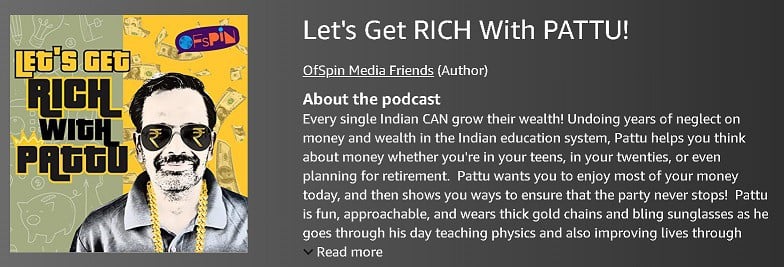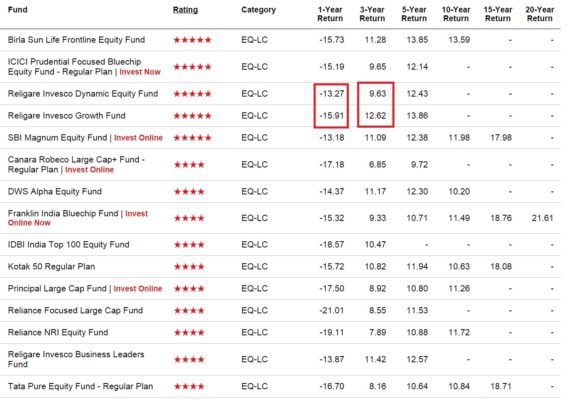Last Updated on August 30, 2021 at 3:40 pm
If we invest in market-linked products like stocks, debt mutual funds, gold etc. it is a good idea to benchmark our returns with respect to the volatility associated with the instrument. This can be done with the an idea known as risk-adjusted returns.
Unfortunately, this volatility is often referred to as ‘risk’. When we refer to the instrument, risk and volatility are one and the same. When we refer to the investment then risk = volatility if the investment tenure is short (~ 5 years). For durations above that volatility leads to notional losses and risk leads to real losses – either due to fall in the instrument or due to inflation. Read more: Equity investing: How to define ‘long-term’ and ‘short-term’
To understand the notion of risk-adjusted returns, let us dive right into an example. This is a screenshot of the Value Research SIP returns for large cap funds. The data from this is used make the Freefincal Mutual Fund Screener with SIP Returns
Join 32,000+ readers and get free money management solutions delivered to your inbox! Subscribe to get posts via email! (Link takes you to our email sign-up form)
🔥Want to create a complete financial plan? Learn goal-based investing? Exclusive access to our DIY tools? Increase your income with your skills? Enjoy massive discounts on our robo-advisory tool & courses! 🔥
I have sorted this in terms of star ratings (because they use risk-adjusted returns). Look at the 1Y and 3Y SIP returns of Religare Invesco funds.
A fund with 12.62% 3-year SIP is a 5-star fund. Another fund with 9.6% 3-year SIP is also a 5-star fund. Why?
Because, their risk-adjusted returns are comparable, although their returns are quite different.
Risk-adjusted return is defined as return per unit risk. This is (typically) a ratio of two quantities – return and risk(volatility).
Return is an absolute measure. Risk-adjusted return is a ratio. High return does not mean high risk-adjusted return!
In the above figure, the fund with 5-year SIP return of 12.57% is a 4-star fund! Why?
Because it took higher risk to achieve those returns.
If you like the notion, I have to be a party pooper. Popular measures of risk-adjusted returns are deeply flawed! Rating agencies use many (if not all) of such flawed measures (another reason to discard star ratings).
The root cause of the trouble is in the way volatility is measured. The most common metric is the standard deviation – the average of deviations from the average! This video may be of help: How to measure risk associated with an equity investment
What most people in the financial services fail to tell you is that the standard deviation is unfit to describe volatile instrument returns. Why?
Because these returns do not fall into a normal distribution – the only requirement for the validity of the standard deviation! Here is some proof:
- What Return Can I Expect From Equity Over the Long-term? Part 2
- Value at risk (VAR): Would you buy a car with a faulty airbag!
If the standard deviation is not valid, then any metric that uses it is also not valid.
Here are some commonly used examples of risk-adjusted return based on the standard deviation:
Sharpe Ratio
Defined as: (return – risk-free rate*)/(standard-deviation)
* return with no volatility – Value Research uses SBI 45-180 days Term Deposit Rate as the risk-free rate.
Invalid because the standard deviation is invalid!
Sortino Ratio
Defined as: (return – risk-free rate*)/(downside-deviation)
Downside deviation is nothing but the standard deviation of only negative deviations from the average. This is also known as harmful volatility.
For example, conside a set of monthly returns:
-25%, 100%, 14%, 60%, -40%, 25%.
The average is ~ 22%.
Some monthly returns are below this average (negative deviation) and some monthly returns are above this average (positive deviation).
The standard deviation uses both +ve and -ve deviations. If only the -ve deviations are considered, then we get the downside deviation. Unfortunately, that does not justify its use!
For the same reasons (albeit a bit too technical for this post), the Treynor ratio, the beta and the alpha are flawed!
I confess that I too have used these ratios extensively in the Mutual Fund Risk and Return Analyzer V 4.0
I realized about these limitations afterwards and therefore, decided to focus on downside and upside capture ratios
Also see:
- Simplify Mutual Fund Analysis with Upside/Downside Capture Ratios
- Mutual Fund Downside Protection Calculator
- Mutual Fund Downside Protection Consistency Analysis
These ratios are not direct measures of calculating returns on a risk-adjusted basis. However, they are simpler to understand and do not depend on the standard deviation.
Another indirect measure of risk-adjusted return is the Ulcer Index. This is an alternative measure of volatility. Read more: Mutual Fund Analysis With the Ulcer Index
You can calculate this with the mutual fund risk and return analyzer.
Conclusion: Risk-adjusted return is a measure of return per unit risk. Although it is useful, commonly used metrics are flawed. Indirect, but simpler to understand measured can be considered as an alternative.
🔥Enjoy massive discounts on our courses, robo-advisory tool and exclusive investor circle! 🔥& join our community of 7000+ users!
Use our Robo-advisory Tool for a start-to-finish financial plan! ⇐ More than 2,500 investors and advisors use this!
Track your mutual funds and stock investments with this Google Sheet!
We also publish monthly equity mutual funds, debt and hybrid mutual funds, index funds and ETF screeners and momentum, low-volatility stock screeners.





- Do you have a comment about the above article? Reach out to us on Twitter: @freefincal or @pattufreefincal
- Have a question? Subscribe to our newsletter using the form below.
- Hit 'reply' to any email from us! We do not offer personalized investment advice. We can write a detailed article without mentioning your name if you have a generic question.
Join 32,000+ readers and get free money management solutions delivered to your inbox! Subscribe to get posts via email! (Link takes you to our email sign-up form)
About The Author
 Dr M. Pattabiraman(PhD) is the founder, managing editor and primary author of freefincal. He is an associate professor at the Indian Institute of Technology, Madras. He has over ten years of experience publishing news analysis, research and financial product development. Connect with him via Twitter(X), Linkedin, or YouTube. Pattabiraman has co-authored three print books: (1) You can be rich too with goal-based investing (CNBC TV18) for DIY investors. (2) Gamechanger for young earners. (3) Chinchu Gets a Superpower! for kids. He has also written seven other free e-books on various money management topics. He is a patron and co-founder of “Fee-only India,” an organisation promoting unbiased, commission-free investment advice.
Dr M. Pattabiraman(PhD) is the founder, managing editor and primary author of freefincal. He is an associate professor at the Indian Institute of Technology, Madras. He has over ten years of experience publishing news analysis, research and financial product development. Connect with him via Twitter(X), Linkedin, or YouTube. Pattabiraman has co-authored three print books: (1) You can be rich too with goal-based investing (CNBC TV18) for DIY investors. (2) Gamechanger for young earners. (3) Chinchu Gets a Superpower! for kids. He has also written seven other free e-books on various money management topics. He is a patron and co-founder of “Fee-only India,” an organisation promoting unbiased, commission-free investment advice.Our flagship course! Learn to manage your portfolio like a pro to achieve your goals regardless of market conditions! ⇐ More than 3,000 investors and advisors are part of our exclusive community! Get clarity on how to plan for your goals and achieve the necessary corpus no matter the market condition is!! Watch the first lecture for free! One-time payment! No recurring fees! Life-long access to videos! Reduce fear, uncertainty and doubt while investing! Learn how to plan for your goals before and after retirement with confidence.
Our new course! Increase your income by getting people to pay for your skills! ⇐ More than 700 salaried employees, entrepreneurs and financial advisors are part of our exclusive community! Learn how to get people to pay for your skills! Whether you are a professional or small business owner who wants more clients via online visibility or a salaried person wanting a side income or passive income, we will show you how to achieve this by showcasing your skills and building a community that trusts and pays you! (watch 1st lecture for free). One-time payment! No recurring fees! Life-long access to videos!
Our new book for kids: “Chinchu Gets a Superpower!” is now available!


Must-read book even for adults! This is something that every parent should teach their kids right from their young age. The importance of money management and decision making based on their wants and needs. Very nicely written in simple terms. - Arun.Buy the book: Chinchu gets a superpower for your child!
How to profit from content writing: Our new ebook is for those interested in getting side income via content writing. It is available at a 50% discount for Rs. 500 only!
Do you want to check if the market is overvalued or undervalued? Use our market valuation tool (it will work with any index!), or get the Tactical Buy/Sell timing tool!
We publish monthly mutual fund screeners and momentum, low-volatility stock screeners.
About freefincal & its content policy. Freefincal is a News Media Organization dedicated to providing original analysis, reports, reviews and insights on mutual funds, stocks, investing, retirement and personal finance developments. We do so without conflict of interest and bias. Follow us on Google News. Freefincal serves more than three million readers a year (5 million page views) with articles based only on factual information and detailed analysis by its authors. All statements made will be verified with credible and knowledgeable sources before publication. Freefincal does not publish paid articles, promotions, PR, satire or opinions without data. All opinions will be inferences backed by verifiable, reproducible evidence/data. Contact information: To get in touch, use this contact form. (Sponsored posts or paid collaborations will not be entertained.)
Connect with us on social media
- Twitter @freefincal
- Subscribe to our YouTube Videos
- Posts feed via Feedburner.
Our publications
You Can Be Rich Too with Goal-Based Investing
 Published by CNBC TV18, this book is meant to help you ask the right questions and seek the correct answers, and since it comes with nine online calculators, you can also create custom solutions for your lifestyle! Get it now.
Published by CNBC TV18, this book is meant to help you ask the right questions and seek the correct answers, and since it comes with nine online calculators, you can also create custom solutions for your lifestyle! Get it now.Gamechanger: Forget Startups, Join Corporate & Still Live the Rich Life You Want
 This book is meant for young earners to get their basics right from day one! It will also help you travel to exotic places at a low cost! Get it or gift it to a young earner.
This book is meant for young earners to get their basics right from day one! It will also help you travel to exotic places at a low cost! Get it or gift it to a young earner.Your Ultimate Guide to Travel
 This is an in-depth dive into vacation planning, finding cheap flights, budget accommodation, what to do when travelling, and how travelling slowly is better financially and psychologically, with links to the web pages and hand-holding at every step. Get the pdf for Rs 300 (instant download)
This is an in-depth dive into vacation planning, finding cheap flights, budget accommodation, what to do when travelling, and how travelling slowly is better financially and psychologically, with links to the web pages and hand-holding at every step. Get the pdf for Rs 300 (instant download)